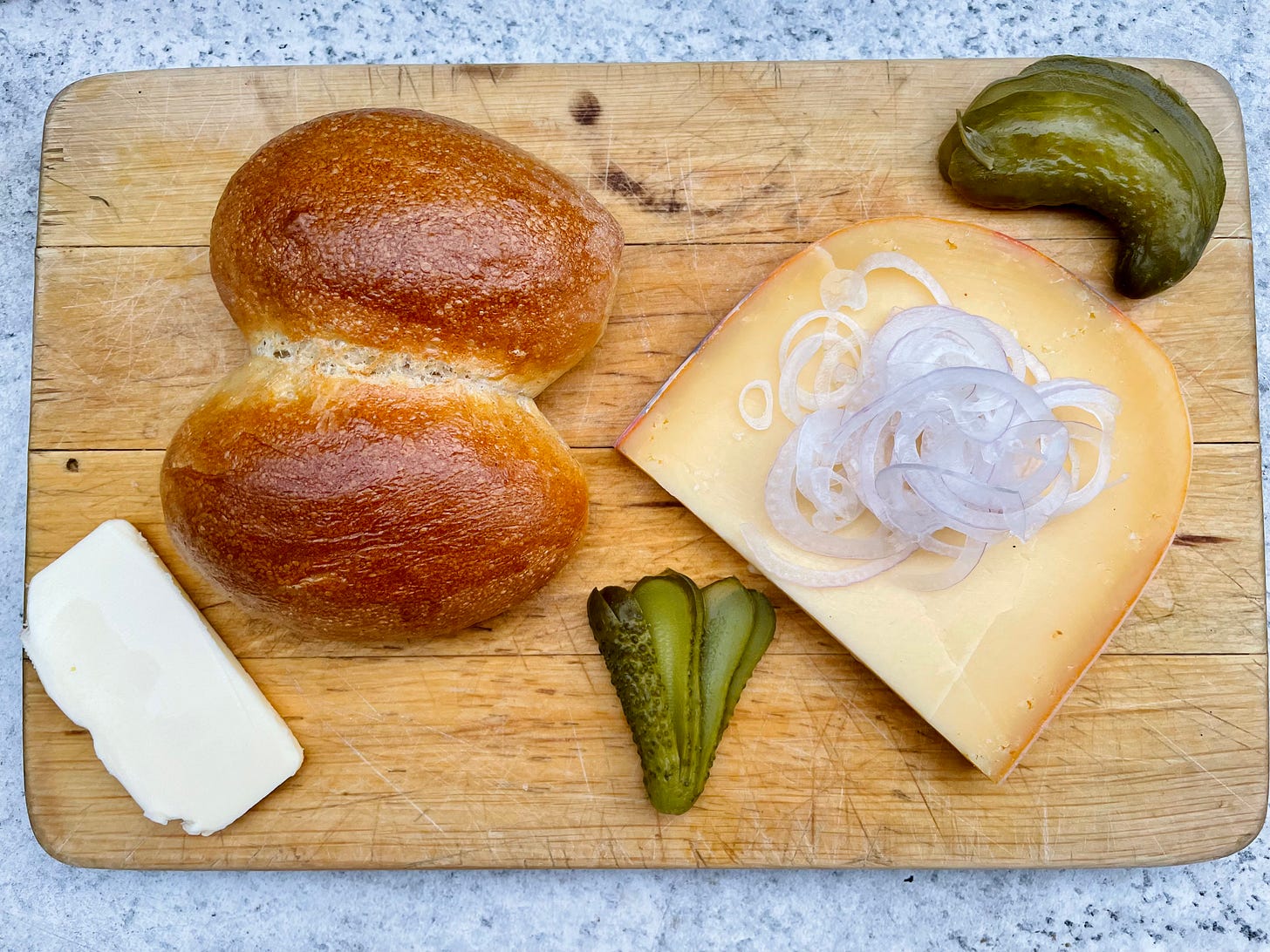
Not a Chicken in Sight: How I Fell in Love with Cologne’s Halve Hahn
It was the late 1990s when I first stepped into a bustling Cologne Brauhaus with my partner. We were visiting the city, and she was eager to show me the best of her hometown. Though she’d spent her teenage years in the Bergisches Land, she still considered herself a Kölsche Mädel at heart. After all, she’d grown up in Köln-Porz, spent her early adulthood in the city, and knew every twist and turn of its vibrant culinary landscape.
I, on the other hand, was a total newcomer, freshly arrived from Lower Saxony. Cologne, with its own dialect, humor, and traditions, felt like a world apart. As we settled into our seats at Früh am Dom—an iconic Brauhaus just a stone’s throw from the towering Kölner Dom—I stared at the menu, eager to try something new. My eyes landed on “Halve Hahn.” “Half a rooster?” I thought, smiling at the mental image of a juicy, roasted chicken arriving at our table.
So, I ordered it with confidence. But when the Köbes—the traditional Colognian waiter—set the wooden board in front of me, I blinked in confusion. Instead of crispy chicken, I saw a rye roll (Röggelchen), a thick slab of medium-aged Gouda cheese, a generous portion of butter, a few pickles, and some sliced raw onions. Everything was neatly arranged on the board, but there wasn’t a feather or wing in sight. My partner laughed at my bewilderment, her eyes twinkling with amusement.
“Did you really think you’d get roast chicken?” she teased, reaching for the small pot of mustard on the table.
I stammered a bit, still adjusting to the reality in front of me. “Well, yeah… doesn’t Halve Hahn mean half a rooster?”
She shook her head, smiling knowingly. “It’s one of Cologne’s little tricks. Halve Hahn is just a rye roll with butter and cheese—nothing to do with chicken. It’s a joke that’s been catching people off guard for decades.”
Mustard on Cheese? Trust the Locals
Before I could even voice my doubts, she reached over and spread a thick layer of mustard directly onto her slice of Gouda. My immediate reaction was one of shock. “Mustard with cheese? Really?” I’d heard of pairing mustard with sausages or meats, but with Gouda? That felt sacrilegious to every taste bud rule I thought I knew.
Sensing my skepticism, she just grinned and offered me her freshly prepared Halve Hahn. “Try it. Trust me.”
I hesitated but took a bite. And—wow! The tangy, medium-spicy mustard paired perfectly with the creamy Gouda and the slightly sour note of the rye roll. The flavors balanced each other in a way I hadn’t anticipated. The mustard didn’t overwhelm the cheese; it enhanced it, cutting through the richness and adding a zing that made each bite pop. From that point on, I was a convert. Mustard and Gouda became one of my favorite combinations—unexpected but brilliant.
The Secret Behind the Roll: What Makes a Röggelchen So Special?
The foundation of the Halve Hahn is the humble Röggelchen—a small rye bread roll that has its roots deep in Rhineland culinary traditions. The name “Röggelchen” comes from the German word Roggen, meaning rye, reflecting its primary ingredient. The addition of the diminutive -chen indicates that these are smaller rolls, often baked in pairs, giving them their characteristic shape: two small rolls joined at the sides.
Röggelchen date back several centuries and are part of a long-standing tradition of baking with rye flour in Northern and Western Germany, where rye was historically a more common crop than wheat. In Cologne and Düsseldorf, Röggelchen are more than just breakfast or dinner rolls—they’re a marker of local identity. The rolls have a firm, slightly chewy texture with a mild sour flavor that makes them ideal for pairing with savory toppings.
While they might be enjoyed at breakfast or alongside a cup of coffee, Röggelchen are most famous as the base for the beloved Halve Hahn. Traditionally, they’re sliced open, spread with butter, and topped with a thick slice of medium-aged Gouda cheese. What makes the dish distinct is that the cheese is usually cut as thick as the roll itself and just about as wide, ensuring every bite is packed with creamy goodness.
From Surprise to Staple
After that initial experience, Halve Hahn quickly became my go-to meal whenever I was in Cologne. A few months later, when I moved to the city for work, I found myself returning to Früh am Dom regularly. The Brauhaus was perfectly situated between my office and the five-person shared apartment I rented during the week—a pre-furnished, overpriced space that felt more like a temporary stopover than a home. My real escape was my own apartment back in Einbeck, where I’d retreat on weekends to recharge from the shared living chaos.
But during the week, Halve Hahn and a crisp glass of Früh Kölsch became my evening ritual. There was something comforting about sitting in that crowded, wood-paneled room, watching the Köbes weave through the tables, trays of freshly poured beers and platters of Halve Hahn balanced on one hand. The clinking of Stangen glasses, the hum of conversations—one part Hochdeutsch, one part Colognian dialect, and eight parts accents and languages from all over Germany and beyond. The Brauhaus felt like a small world unto itself, a place where locals and travelers came together over simple food, good beer, and shared laughter.
Each bite of Halve Hahn reminded me of that first surprise. The mustard’s tang, the butter’s creamy richness, the crunch of the pickles—it was all there, exactly as I’d tasted it that first evening. Even if I didn’t exchange more than a few polite words with anyone, I felt like I belonged. Halve Hahn was more than a meal—it was my way of connecting to the city.
A Lifesaver for the Late-Night Crowd
Working late hours often left me scrambling for a meal. In Germany, most restaurants shut down their kitchens by 20:30, and I’d wander from one place to the next, only to be greeted with a sympathetic, “Sorry, the kitchen’s closed,” or “They’re already cleaning up.” But Früh am Dom was different. No matter how late I walked in, I could always count on the Halve Hahn. It was a lifesaver on more than one occasion, and I started looking forward to that familiar wooden board arriving at my table, knowing it would be there for me, even after the longest days.
The Kölsch Experience
Cologne’s Brauhaus culture isn’t just about the food—it’s also about Kölsch, the city’s signature beer. Pale and top-fermented, Kölsch is served in small, slender 0.2-liter glasses called Stangen. The Köbes will keep bringing you fresh glasses as long as your beer mat remains off the top of your glass. It’s easy to lose track of time (and glasses!) as the Köbes move through the room with almost choreographed precision.
If you want to truly experience the magic of a Brauhaus, take a moment to stand near the tap area. Watch as wooden barrels are hoisted up from the cellar by an old-fashioned lift. The Zappes (the tapper) plunges the tap into each barrel and doesn’t close it once until the barrel is completely drained. He fills glass after glass in one smooth motion, without missing a beat. It’s a mesmerizing sight—one that adds to the rhythmic, lively atmosphere of the Brauhaus.
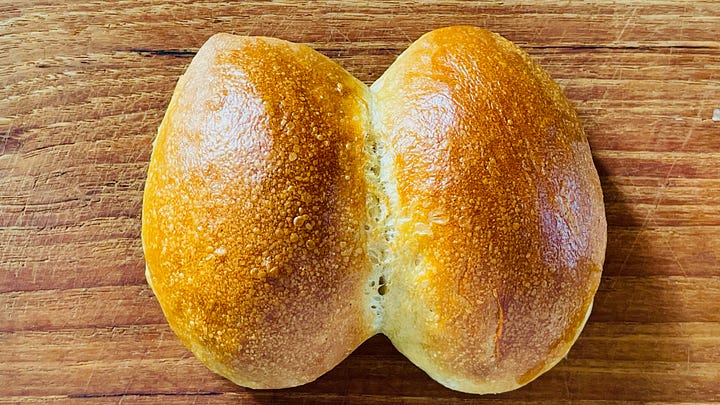
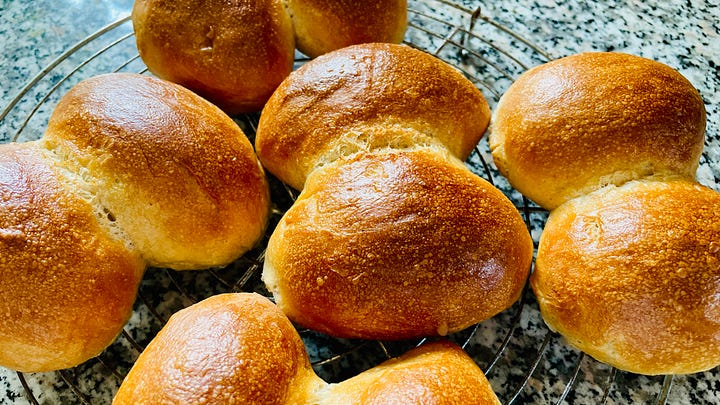
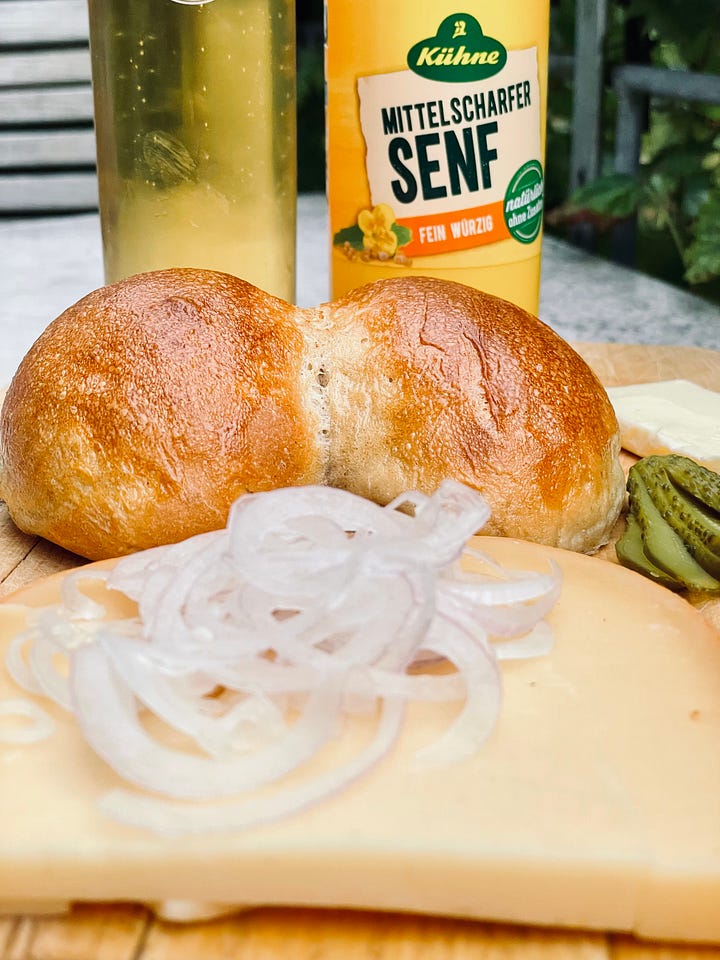
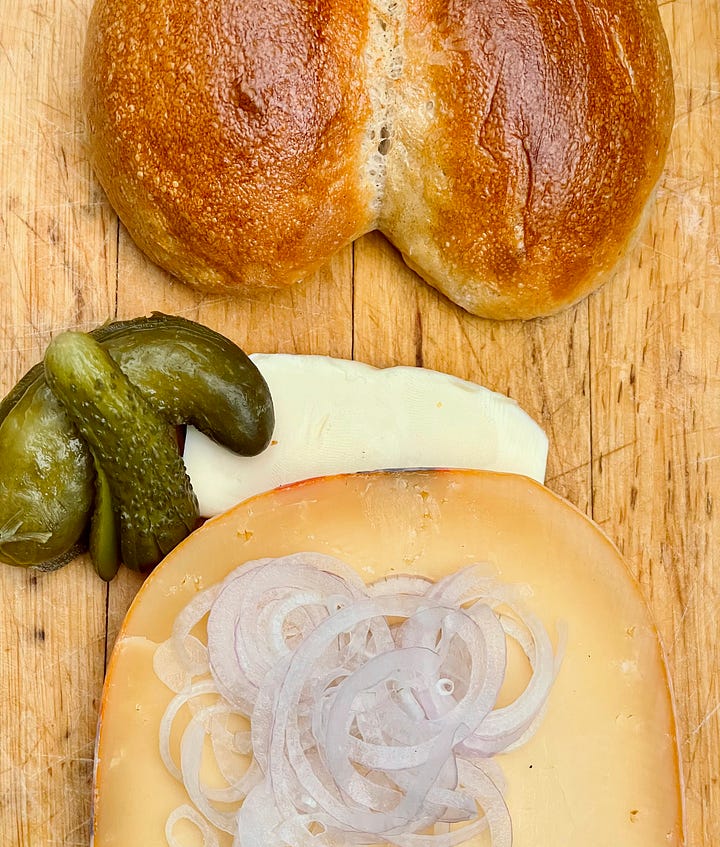
Recreate Your Own Halve Hahn
Curious to try this classic dish at home? Here’s how you can bring a bit of Cologne’s charm to your table:
Ingredients:
1 small rye roll or Röggelchen (see recipe for paid subscribers below)
1 thick slice of medium-aged Gouda cheese (cut to cover most of the roll’s surface, about as thick as your little finger) or a rather strong tasting cheese that is available to you.
A generous slab of unsalted butter
1 tube of medium-spicy German mustard (recommended brands: Kühne classic or Löwensenf medium-hot. Avoid Löwensenf’s extra-hot variety for this recipe!)
A few slices of spiced gherkin
Thinly sliced raw onions (optional) — soak in cold water for about 30 minutes to reduce sharpness and enhance crunch
Instructions:
Arrange all the ingredients on a wooden board or plate, just as it would be served in a Cologne Brauhaus.
Slice the rye roll in half and spread a thick layer of butter on the inside of both halves.
Place the generous slice of Gouda on one half, ensuring it covers most of the roll’s surface area.
Add a few slices of pickles and some raw onions if desired.
Serve with a pot of mustard on the side and a cold glass of Kölsch (or the best light beer you can find!).
The Heart of Cologne on a Plate
What started as a moment of confusion turned into a love affair with one of the city’s most beloved dishes. The Halve Hahn became a symbol of comfort, community, and connection—more than just a meal, it’s a part of Cologne’s soul. So if you ever find yourself in the city, walk into a Brauhaus, order a Halve Hahn, and savor the experience of local humor, tradition, and good company. Sometimes, the best discoveries are the ones you never saw coming. 🍻😄
If you’d like to experience a bit of Kölsche Lebensart at home but can’t get your hands on Kölsch, any light and tangy lager or non-alkoholic beverage of your liking can of course be used as a substitute. You might even experiment by swapping the Gouda for some of your local spicier cheese varieties or lactose-free varieties to add your own twist.
The one thing you absolutely cannot substitute is the Röggelchen itself—its unique flavor and texture are essential to the Halve Hahn experience. That’s why I’m sharing the recipe below, so you can bake these special rolls right in your own kitchen. Enjoy!
Each tweak, twist, and taste test in my kitchen comes with its own story of creativity—and yes, a little bit of cost, too. Since I’ve been on sick leave since January 2024, I’m navigating a tight budget of 400 Euros per month for myself and my cat.
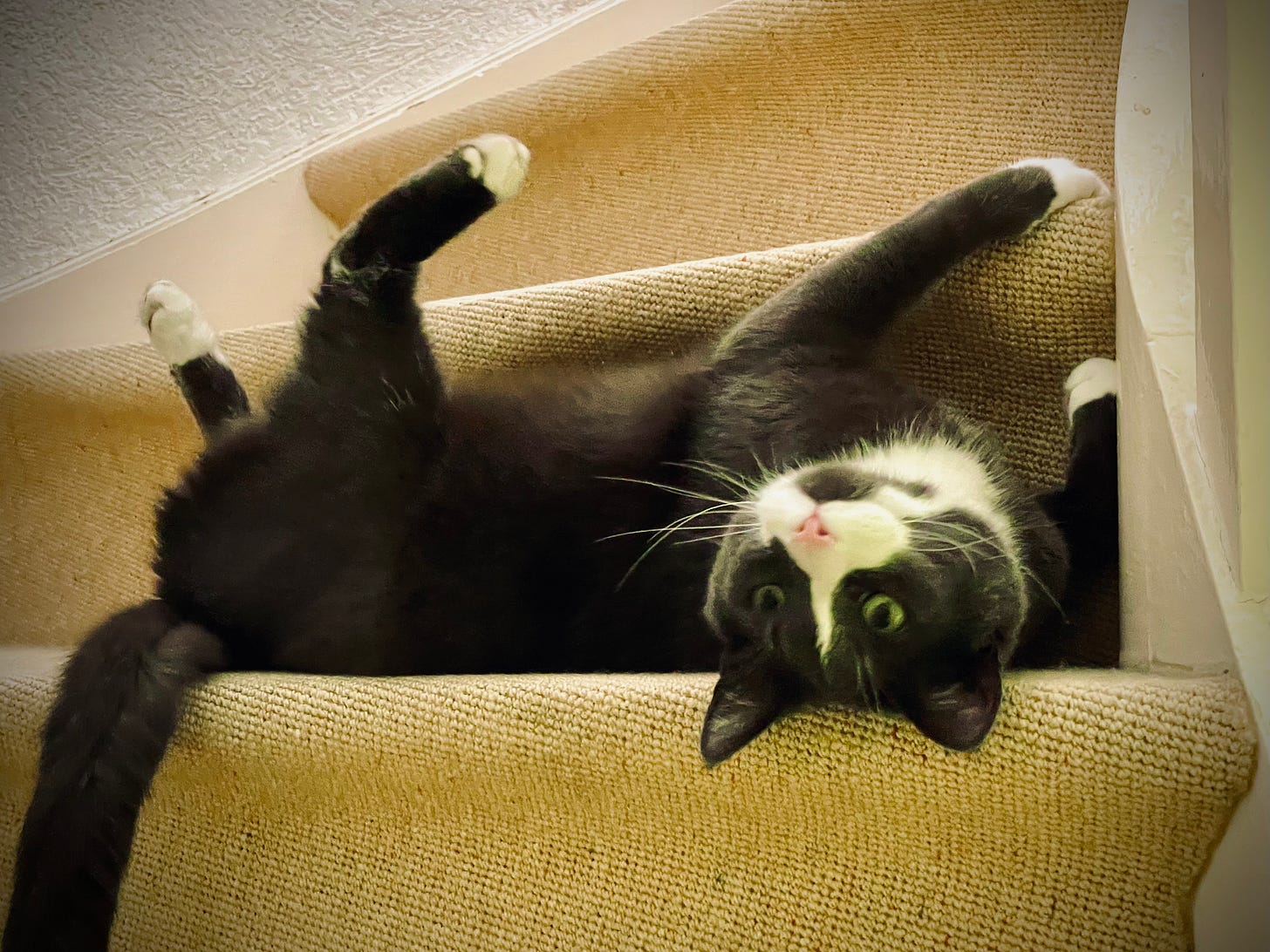
If you find joy in these culinary explorations, I’d be deeply grateful if you’d consider treating yourself to a monthly or yearly subscription to support this publication.
Your generosity not only keeps these flavors and stories alive but also empowers me to continue experimenting and sharing them with you
Röggelchen - Cologne's Rye Rolls
Yield: 4-5 double rolls
Ingredients:
Sourdough Starter:
55 g (1.9 oz) whole grain rye flour
55 g (1.9 oz) water
5.5 g (0.2 oz) sourdough starter (Alternatively, use a mixture of rye flour and water to create a starter over several days.)
If you really want to try my recipe of Röggelchen without subscribing, just DM me…and I’ll sent you the rest…
Keep reading with a 7-day free trial
Subscribe to Wild Lion*esses Pride by Jay to keep reading this post and get 7 days of free access to the full post archives.




